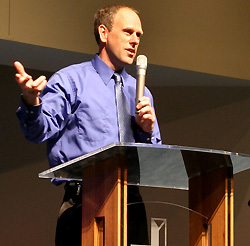
Aim For Consistency
“We are what we repeatedly do,” Aristotle once wrote. “Therefore, excellence is a habit not an act.”
Doing everything right with sound in a performance is hard enough, but repeating it can seem impossible, especially when different volunteers are involved.
To raise the percentage of success, standardize the layout of your mixing console, label it, and then get everyone to conform to it.
Example: I always lay out my mixing console with drums on the left, followed by bass, electric and acoustic guitar, then keyboards, and finally vocals.
The lead vocal is always in the farthest right channel next to the subgroups and masters. I’ve been doing that for the past 25 years. My technical team follows this layout consistently.
How you lay out the board doesn’t matter as long as it’s logical and everyone follows it. The advantage of such a layout is that when something goes wrong or there’s feedback, you know instinctively what to grab to fix it.
Aim for consistency also with equipment storage. Organize cables, stands, and mics so that even with last-minute changes, such as having to work with five singers instead of the four you had planned on, you can secure the proper equipment to keep a rehearsal moving.
Preparation, Preparation
When I was on staff as a technical director, I was blessed with a worship leader who provided worship-service outlines weeks in advance. I used to kid him that the Spirit moved in him two weeks before it hit the congregation.
One lesson I learned from him is that someone who is well prepared is able to respond much better to last-minute complications than someone who wings it.
I have served as a consultant to churches that supposedly had sound system problems, only to discover that the real problem was poor preparation.
Example: A sound team shows up at 8 a.m. to set up for a 9:30 a.m. service in a temporary facility. By 9 a.m. the sound system is set up, and a CD is playing. Musicians begin arriving for a last-minute rehearsal.
The service starts seven minutes late. That’s bad enough, but what’s worse is that there has been no time for sound checks and input testing. The service proceeds, accompanied by hums, cracks, pops, and a lousy sound mix.
Ninety minutes later, the sound crew is exhausted, the musicians disgusted, and the pastor fed up. He decides to call in a sound expert.
He needn’t have spent the money. Preparation would have alleviated most of the problems.
Preparation means sending information to your team well in advance of a service. Email (or post on the church’s website) the order of worship for the Sunday service to crew members early in the week so they can get a jump-start on what they’ll need to do.
Preparation also means performing sound checks with musicians prior to the service and testing all microphones. Even if the same person leads worship every week, he or she may have a cold or feel insecure about a piece of music and need their monitor turned up.
The key is to show up early, anticipate the unexpected, and be prepared. You can’t be too prepared.
